
7 mins
OpenCan Instagram Be Used To Boost SEO Strategies?
6 mins
One of the unique attractions of using Pinterest for businesses is the ecommerce and advertising element. Follow this guide to set up an SEO friendly Pinterest page and start making the most of your pins.
19th January 2015

The advantage of setting up your account as a business is that you can be verified
Pinterest has seen an unprecedented rise in popularity since its conception in 2009. In five years it has grown from the brainchild of co-founders Ben Silbermann, Evan Sharp and Paul Sciarra into the social media and online shopping leviathan it is today.
One of the unique attractions of using the site for businesses is the ecommerce and advertising element. Being able to create custom boards for latest collections, best sellers or categories such as men’s jackets has allowed stores to show off their wares on a daily basis, for free.
Making the most of the conversion opportunities on Pinterest is an easy way for both small and large businesses to share their products with a waiting audience. All you need is to take time to curate your page. Follow this guide to set up an SEO friendly Pinterest page and start making the most of your pins.
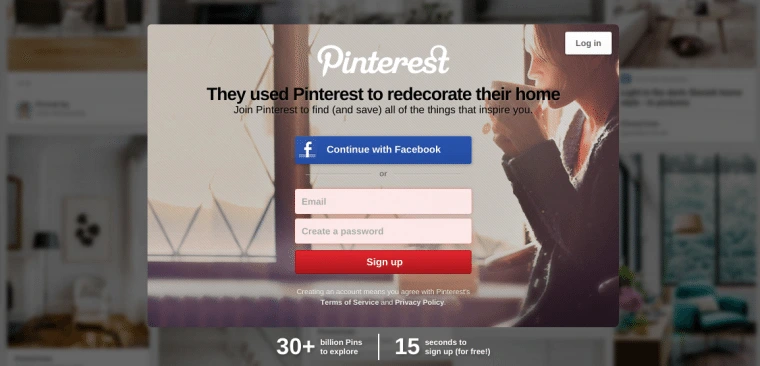 Pinterest Login
Pinterest Login
Setting up as a Business
Pinterest offers two varieties of account, personal and business. The advantage of setting up your account as a business is that you can be verified, meaning that you have an added marker that legitimises your pin board to potential customers – like on Twitter.
Getting Verified
Gaining verification is a simple process that will help Google to see your page as trustworthy. You can get your page verified by making a unique code for your Pinterest page and inserting it into the homepage code of your website. This creates a digital connection between the pages.
Claiming your URL
As a business page, you have the option of claiming a URL for your Pinterest account (as long as it hasn’t already been taken). You’d be surprised by how many good ideas are taken the world over, especially as we all want a searchable name.
For example, obvious names for flower sellers such as The Flower Shop or The Florist are likely to have already been taken. Think outside the potted plant.
Search Privacy
Some personal accounts prefer not to spread their images across the web, but for businesses it is particularly advantageous to be able to. Make sure you capitalise on getting your images in search engine results pages by updating your privacy settings to allow Google a look in.
Find online databases of images for you to use
Though you’ll also be adding your own images to Pinterest, your boards shouldn’t be full of only your own products. Adding ‘original pins’ – pins you’ve uploaded, as well as repinning is key part of using Pinterest properly.
Gather a list of sites that you can pull images or lists of images from for your ‘original’ pins.
These can include:
Through creating six boards, you will have identified six key areas of interest or aspects of your business that you think potential pinners will be interested in seeing.
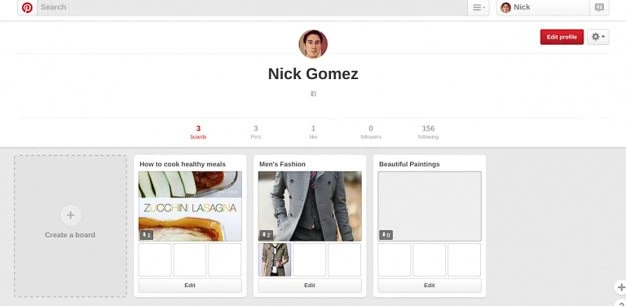
Start with 6 boards, each with 10 pins
This will give your page somewhere to go and a solid base to start building. Through creating six boards, you will have identified six key areas of interest or aspects of your business that you think potential pinners will be interested in seeing.
Create boards based on key themes
Most popular boards fall into one of these category themes:
Matching ‘About’ descriptions
While you’ll often be encouraged to be creative and unique by authorities in the SEO world, this is one instance where uniform descriptions are a must. Make the short 160 character description match the opening lines of your website, your Twitter bio and Facebook page description.
On some platforms you will have more room to write longer descriptions but if you keep your opening succinct and informative, you’ll be more accessible and your linked accounts will be more effectively matched.
Optimise Board names
Choose names for your boards and pages that reflect what potential pinners will search for. This means using keywords to target your audience and avoiding your brand words or names. For example, don’t call your board Firefly (a brand), call it Fruit Juice Drinks (items).
These can be included, but you want to be found by new users not just the ones who know about you already.
Organise your Boards
When potential pinners try to view your page while scrolling through their pinfeed, they will only see (up to) ten boards in two rows of five. So make sure the most popular, updated and interesting boards are organised at the top.
Refresh Board Covers
Change the cover image of your boards every so often. This will show new and returning users a fresh side to your boards every time they check out your profile. It will make your Pinterest account look active and engaged.
Create/Join Collaborative Boards
Finding Collaborative boards is tricky unless you use a directory, such as http://pingroupie.com/.
If you want to join a collaborative board, you’ll usually need to make a request from whoever runs the board. Collaborating gives you excellent exposure to your target demographic and lets you view their followers instantly.
You can also set up your own group boards to encourage interaction with not only the Pinterest community but your customers.
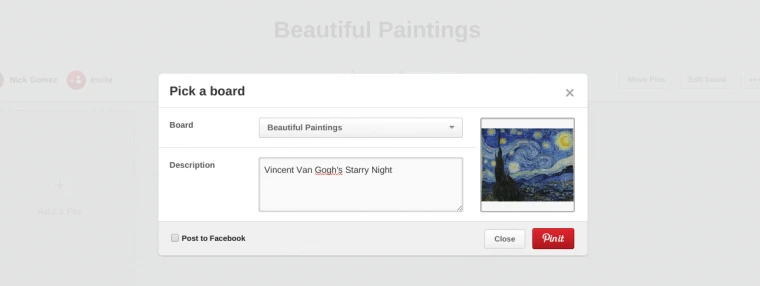 Pinning
Pinning
In each of your pins you should include a link to your product page every time.
Full Pin descriptions
Your pins should have full descriptions with as much relevant information as possible. The most important information, such as the name or title of the item/place/product should be the first thing the potential pinners read. Give a good description with keywords including how the item might be used or beneficial.
Pin data is pulled from descriptions or meta tags
Use metatags on the images on your main site. This will inform the pin description when it is pinned to Pinterest.
Create Rich Pins
Meta tags can be used to create Rich Pins. These broadly categorised pins come in five varieties:
Rich pins are built into the code/HTML of your website at rel=”nofollow” oEmbedded endpoint – one of the formats for adding embedded content such as photos or videos to a link when posted to another site. Such as when an image from an article appears when you post the URL to the post to Facebook. You can also use Schema or Open graph meta tags.
Rich pins require different key information
Product: Pricing, Availability, Where to buy (link).
Article: Headline, Byline, Author.
Place: Map, Address, Phone Number.
Movie: Ratings, Cast, Reviews.
Recipe: Ingredients, Cooking Times, Serving Sizes.
Links to Product Pages
In each of your pins you should include a link to your product page every time. There is an automatic ‘no follow’ for pins, but while you aren’t getting link juice, you will be getting people to your page which can lead to browsing and sales.
Include Prices to get clicks
30% of the pins on Pinterest that are repinned include a price. Frequent users of Pinterest seem to be using the site not only to collect ideas and interesting images, but they are using it to shop. Make pinning interesting and easy for users by giving them all the information about a pin from the start. If someone sees a shirt they like on pinterest, they will likely want to know how much it is and where they can buy it.
Include Alt Tags
Increase your pins’ searchability by adding useful Alt Tags. Additionally, when uploading images for your own pins, ensure that the upload name is not just the image number but includes the name/description of the image. i.e. ‘warwick_castle_night’.
Create pin links for your images
You can add links to your other social media sites, creating a small pin icon that links back to your Pinterest page.
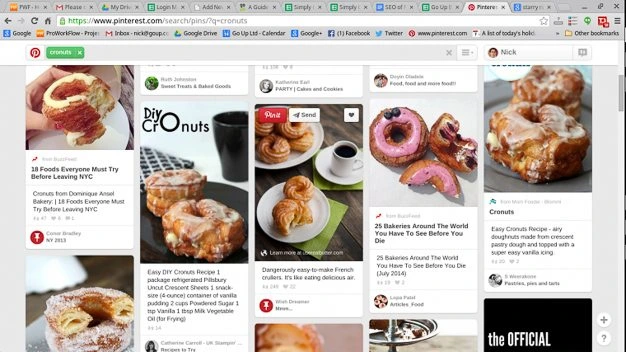 Repinning
Repinning
Don’t just pin your business!
potential pinners don’t just view a pinner’s page to see pictures of one thing. Even if your business is centred on one location or main product, create boards about similar items and interests that potential pinners would like to see. For example, if your business is cakes, include a board of birthday themes, impressive pastries (like cronuts or profiterole towers) or tea sets.
Pinners respect a diverse pinner and will likely follow all of your boards if there is more than a couple that interest them.
Update regularly
There is no point in uploading all the business product and event pictures you could ever want potential pinners to see and then just leaving your Pinterest for them to find. What pinners want to see is a page that is regularly curated with new content.
Pinterest rewards those who have lots of activity. Aim for 20-25 pins per day.
Post Original Pins as well as Repinning
80% of the pins on Pinterest are repins. However, adding original content, adding to the overall value of Pinterest is considered good practice too.
‘Call to arms’’ pins have 80% more engagement and are ideal for cross platform promotions.
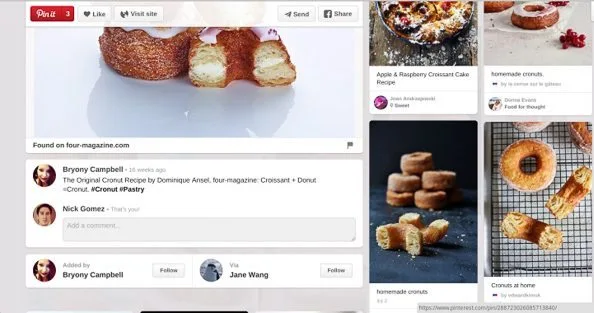 Sharing a pin
Sharing a pin
Use 2 Hashtags when Sharing
Two #hastags per pin is ideal, when sharing across other platforms – such as Twitter. Pins with #s get twice the engagement of those with none.
While pins with 1 or 2 hashtags have an increased engagement of 21%, any more than that can result in 17% less engagement from the initial increase.
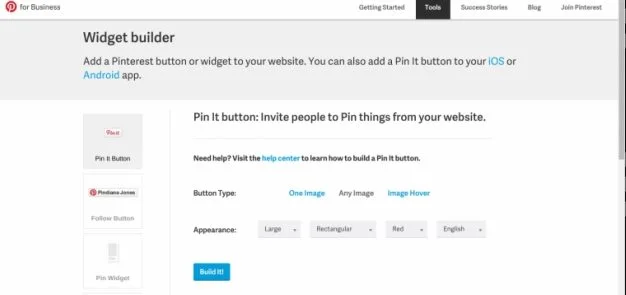
Contests
Use ‘Pin It to Win It’ contests to improve your brand visibility. You’ll be getting pins, bring users to your Pinterest page and therefore, be driving traffic to your site.
‘‘Call to arms’’ pins have 80% more engagement and are ideal for cross platform promotions.
‘Pin It’ badges on your website
Install the pin option on your main website and the images on it.
Pins should be long and narrow not short and wide.
Peak times:
Saturday Morning
Wednesday
Thursday
Weekdays: 2pm – 4pm & 8pm – 11pm
Use bright images not dark ones.